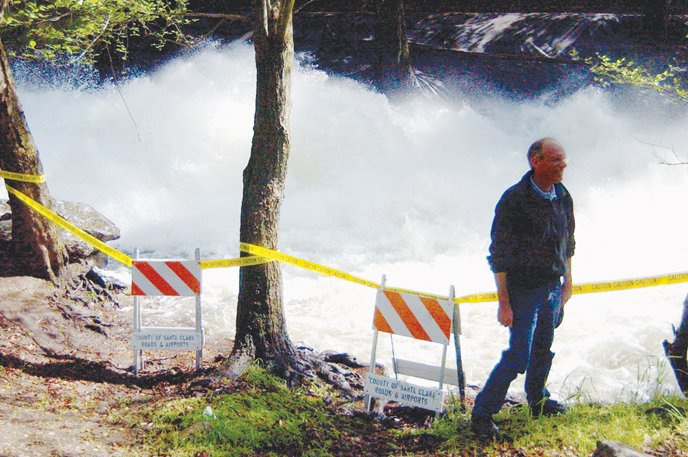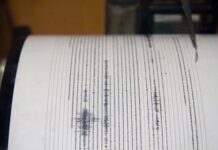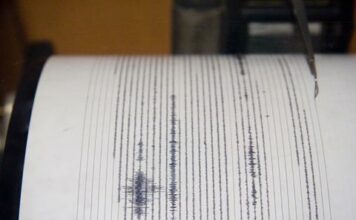A major earthquake near Anderson Lake east of Morgan Hill could
cause the reservoir’s earthen dam to collapse and send a wall of
water rushing toward downtown.
City officials and residents downstream from Anderson Lake were not surprised to learn that Gilroy and Morgan Hill could flood if a major earthquake occurs on a fault that runs under the reservoir.
A new preliminary study released this week by the Santa Clara Valley Water District says the 240-foot-high dam holding back the county’s largest reservoir could crumble if a quake of 6.6 magnitude or higher is registered on the Calaveras fault directly beneath the lake, or a 7.2 quake occurs within a mile or two on the same fault. In such an event, the top of the dam could slump and allow water to spill over, the study says, potentially sending a 35-foot wall of water rushing to downtown Morgan Hill, flooding Gilroy, San Martin and the entire valley floor up to San Jose within a couple of hours.
District officials say that because the reservoir is currently only about 64 percent full, the risk of flooding is low.
“Even if we were to experience a major earthquake, there’s not enough water in the reservoir to spill over the dam at this point,” said district spokeswoman Susan Siravo.
Furthermore, the district announced Monday that it will not allow the water level at Anderson Lake to exceed 87 percent of its capacity, keeping the water level about 30 feet or more below the top of the dam, until more extensive studies are completed. Those studies will look at, among other things, whether or not the dam should be reinforced.
“Although the results of the study are preliminary and based on limited information, the water district is taking additional steps to ensure the safety of the dam,” Siravo said. All the district’s dams have survived previous earthquakes with no damage, she added.
The study was done as part of the district’s ongoing efforts to monitor the safety of the 10 reservoirs and dams it owns in Santa Clara County. Siravo said those efforts include completing detailed seismic analyses of eight of the district’s dams by 2013.
A state-mandated “inundation map” produced by the district in 2003 shows that in a “truly worst-case prediction” in which Anderson dam collapses when the reservoir is full, downtown Morgan Hill could be underwater in 14 minutes, according to Dave Hook, engineering manager for the district’s dam safety unit. In two and a half hours, Gilroy would be underneath 14 feet of water, Hook said.
However, he said other studies have shown that dams are likely to slump no more than 15 percent of their height if they fail. The district plans to keep the water level at Anderson Lake far below the level to which the top of the dam would drop if it failed.
While city officials and the water district believe that the doomsday scenario considered in the study is unlikely, they are responding cautiously.
The Gilroy Fire Department holds at least one major drill annually in preparation for floods and earthquakes, said Ed Bozzo, battalion chief of field operations.
“Fortunately we do practice these scenarios,” he said. “We’re pretty well prepared to handle both types of disasters. There’s nothing we can do to stop it, but we can deal with it.”
Though Bozzo hoped the department would never have to deal with the worst case scenario, he worried about having the manpower to divert a flood of such large proportions.
“We’d be cut off from the rest of the county so getting the resources to assist us would be problematic,” he said.
He also encouraged families to map out an escape plan and emergency prevention and preparedness tips can be found on the city of Gilroy’s Web site.
Morgan Hill has considered a failure of Anderson Dam a worst-case possibility in their emergency response preparations since it was built in 1950, Mayor Steve Tate said. The recent study, which was released Monday, reminds the city of the potential devastation looming overhead.
“We do have plans in place on how to react,” Tate said calmly. “Any time you have a dam, there is a possibility that some kind of disaster can happen, and you’ve got to work hard to minimize any chance of danger.”
The SCVWD board of directors will discuss the study at its scheduled meeting Tuesday. The city will be there to ask the district to keep the reservoir no higher than its current level, rather than allow it to fill up to 87 percent capacity, according to City Manager Ed Tewes.
“The preliminary engineering report they released indicated there is a greater risk than we had previously thought, and that risk needs to be fully evaluated,” said Tewes. “Until it is fully evaluated, then it would be more prudent to maintain current levels.”
The city’s emergency plan includes using an automated telephone message system to notify residents of an impending disaster, according to Jennifer Ponce, Morgan Hill’s emergency services director.
“Our primary responsibility is to ensure the citizens are aware of the risk, and remind them to prepare themselves,” said Ponce. “Our emergency staff is trained to respond to these kinds of disasters.”
She noted that a quake of 6.6 magnitude or higher in Morgan Hill, even without a failure of the dam, would be a substantial disaster requiring a coordinated response by the city and surrounding agencies.
The first properties to be flooded in the event of such a calamity are a cluster of neighborhoods containing upscale homes on Cochrane Road and Malaguerra Avenue.
Residents there don’t feel threatened, as the study doesn’t raise the probability of a high-magnitude earthquake in Morgan Hill.
“The likelihood of that magnitude an earthquake is about as close as winning the lottery,” said Sean O’Hare, 23, who lives on Malaguerra Avenue below the dam and across the street from Coyote Creek, which carries runoff from the spillway.
O’Hare said he knew he was in a dam failure area when he purchased his home two years ago, as a disclosure is required when any property sale occurs in the area that would be affected. “It’s been in the back of my mind since I moved in,” O’Hare said.
Next in line to be flooded by a dam failure would be the Cochrane Commons shopping center which contains Target, Chili’s and a number of other restaurants and retail stores. Patrons and employees there weren’t worried either. Most of those contacted by the Times were unaware of the report.
Kim Toves, a Gilroy resident and customer at Coyote Creek Realty in Cochrane Commons, said while the risk of a flood-inducing quake might be low, she understands the concern. “I would support any initiative that would put money towards retro-fitting the dam if it’s needed,” said Toves.
The manager of Radio Shack, Brian Smith, didn’t even know there was a dam so close to his store. He is also aware that a major earthquake is an unlikely occurrence.
There is about an 11 percent chance that a quake of magnitude 6.6 or greater will occur on the Calaveras fault in the next 30 years, according to David Oppenheimer, a seismologist with the U.S. Geological Survey. The likelihood of a 7.2 magnitude earthquake is about 2 percent in the same period. The largest quake ever measured on the fault that runs under the reservoir is about 6.5 in 1911. On August 6, 1979, a 5.9 earthquake shook Coyote Lake.
A 6.2 quake occurred on the Calaveras fault April 24, 1984, Oppenheimer said. That temblor caused minor damage to residences and commercial buildings throughout Morgan Hill and knocked several homes off their foundations, but no deaths or serious injuries were reported. The water district reported surface cracks on Anderson Dam as a result of the quake.
Hook explained that AMEC Geomatrix, who conducted the study, reached its conclusions by boring 31 holes in the dam. He said one of those borings showed that the dam’s downstream foundation contains mud, gravel and sand, while it should ideally be solid bedrock.
“We are making a conservative assumption that the upstream and downstream shelves contain (the looser material),” Hook said.
Siravo said the district can easily control the level of Anderson Lake, which is often used to store imported water due to its large size. She said district engineers are confident that the proposed maximum level of 87 percent capacity is safe.
“Their analysis showed that a safe water level for Anderson Dam would be restricting it to 30 feet below the crest of the dam,” said Siravo. “Under the temporary reservoir operating restriction which we put in place following the results of the study, the District will no longer be able to allow winter runoff to fill Anderson reservoir.”
She added that even at the current level, the reservoir is still suitable for boating and other recreational uses.
The SCVWD board of directors meeting will take place 9:35 a.m. Tuesday, at the district headquarters at 5700 Almaden Expressway in San Jose.














